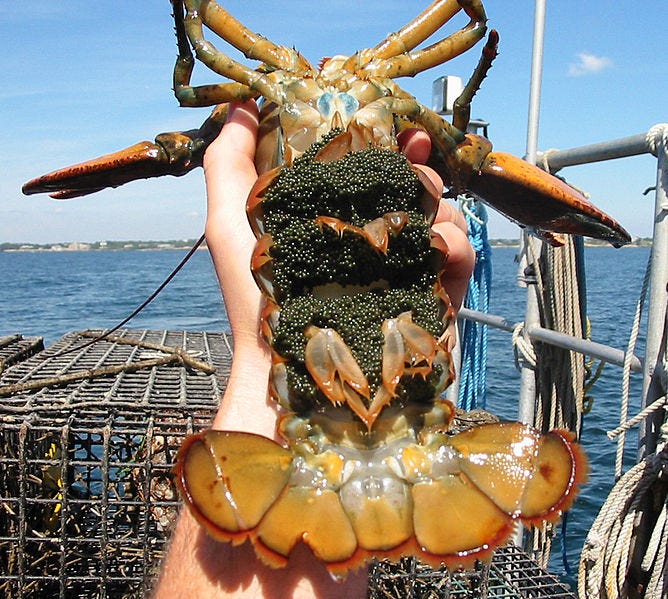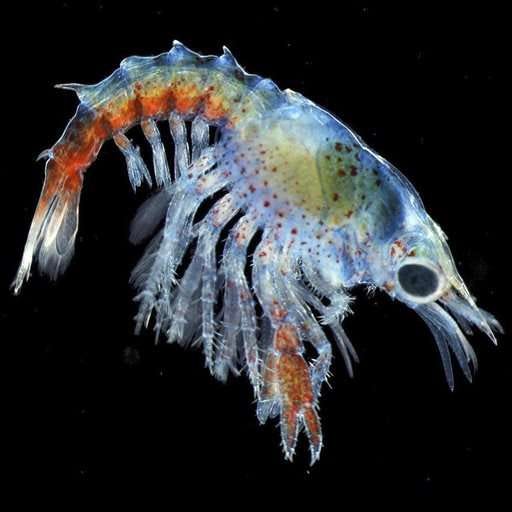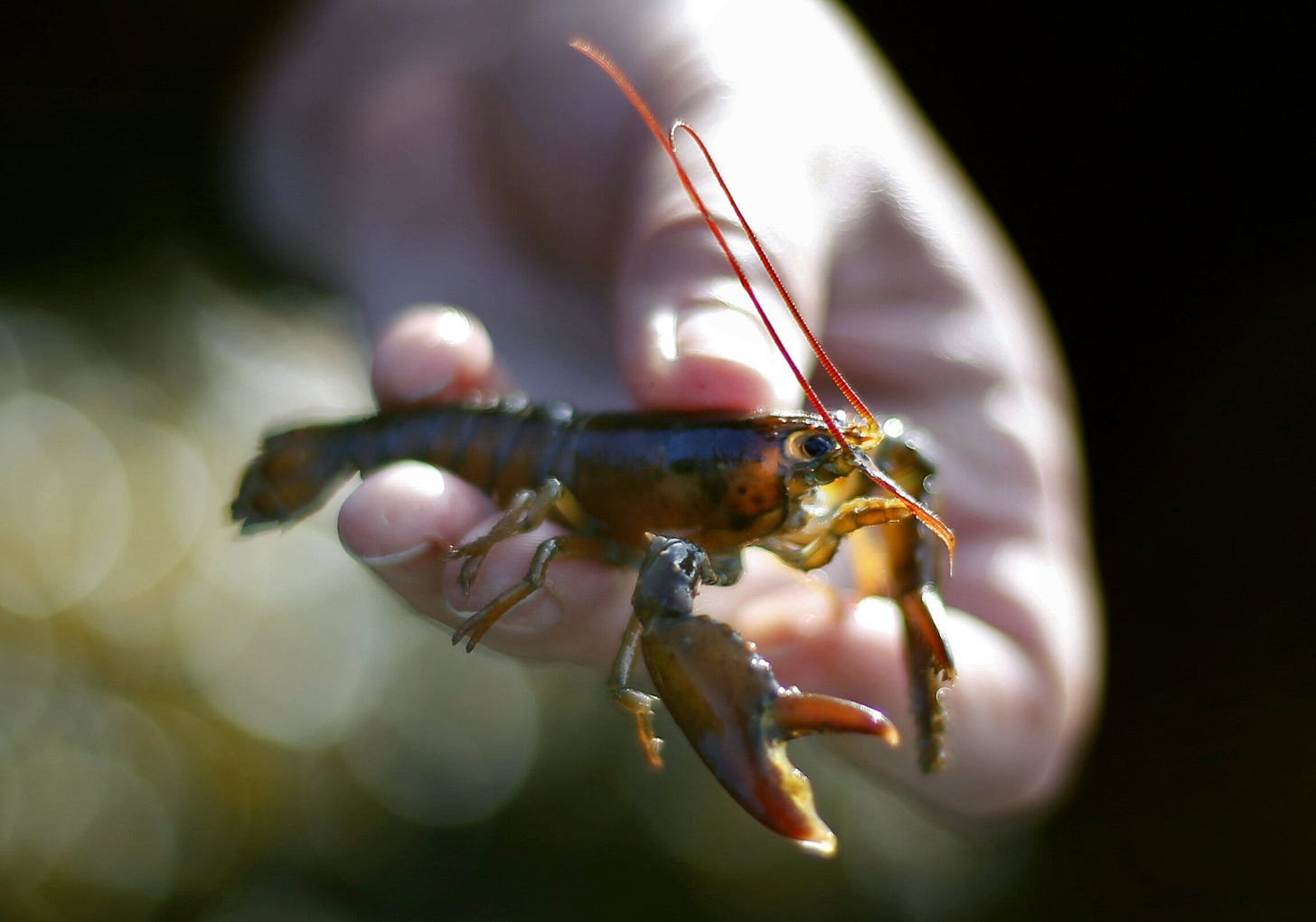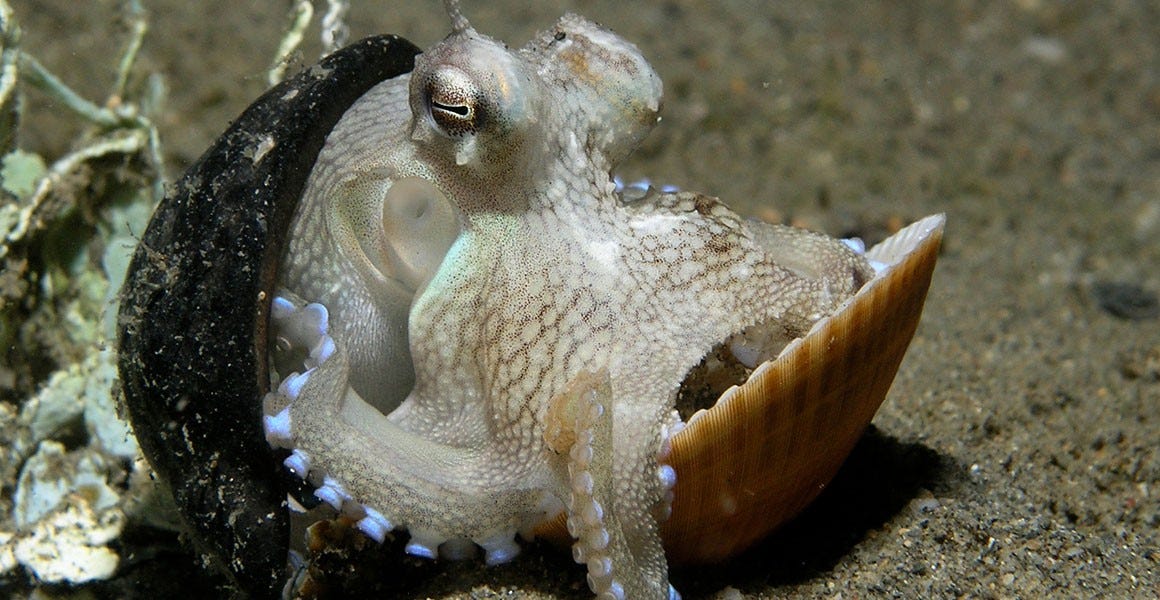The largest recorded lobster weighed over 44 pounds, was 3.5 feet long, and was estimated to be 100 years old when he was caught off the coast of Nova Scotia in 1977. Well, you were lucky, dude. While the average age for a lobster in the wild is around 50 years, the vast majority of these animals won’t make it beyond eight. That’s because people like to eat them before their flesh gets tough.
Lobsters are rather strange creatures. They belong to an order of crustaceans called decapods, “ten-footed”, because they have ten appendages that are considered legs. Eight of those are a lobster’s walking legs, and the three front pairs bear claws. The first of these pairs, while biologically legs, developed into the characteristically large claws. They often are asymmetrical: the larger claw is used to crush the lobster’s prey, and the smaller one acts like a pincer or cutter; it has sharp inner edges and is used for holding the prey. If they lose one of these claws, lobsters can regrow them!
While there are about 75 different lobster species, only 16 of these end up on dinner plates and are eaten regularly, in the amount of 122,000 tonnes of North Atlantic Ocean lobsters caught annually. That’s 268,963,960 pounds or almost 269 million pounds – a lot of living creatures. Globally, it’s a multi-billion-dollar industry. And according to the culinary seafood lingo, the animals are “harvested” – plucked off a lobster tree when they’re ripe for the picking? They must taste better than killed lobsters.

The growth process of a lobster is fascinating. The female has a receptacle where she stores the sperm packets (spermatophores) which the male inserted when they mated. She can keep the sperm for 15 months, even up to two years. When she releases her eggs, they pass through this receptacle and are fertilized by the sperm stored there. There are tens of thousands of them, and for the next ten to eleven months the female carries the eggs around with her, after she glues them to her tummy.

The little embryo molts several times within the egg, and it takes ten to eleven months until the baby is ready to hatch. During this time, the Lobster mom regularly cleans the eggs and fans them with water, to provide sufficient oxygen.
Growing up is quite a challenge for baby lobsters. They’re almost invisible when they hatch – partly because they’re transparent, and partly because they’re tiny, only ⅓ of an inch long. Over the next ten to twenty days they molt three times, each time a bit larger than before. Maybe transparency protects them from predators somewhat; still, only one out of 1,000 will reach the next, juvenile stage.

At this point, they undergo a metamorphosis to reach the post-larva stage: they’ll evolve looking more like adult lobsters, sink to the ocean floor (that’s where the adults live, where they can hide in crevices and burrows), and they start using their legs and tails to swim around. And from now on, lobsters will molt throughout their whole lives, although less frequently as they get older. Their hard, outer shell becomes too tight as they grow, and it splits open to let a soft, larger body emerge.

This happens about ten times during the first one to two years, whereas an old lobster molts only once every few years. Other than that, age doesn’t seem to affect them: they don’t slow down, they don’t weaken, and an old lobster may be more fertile than a younger one. That’s why they can reach an impressive age – if they don’t end up on a dinner table.
And there are some other peculiar features: Lobsters have blue blood, just like octopuses, snails, and spiders. It contains the blood pigment haemocyanin which includes copper, as opposed to red blood: hemoglobin, which contains iron. The lobster’s four-chambered heart pumps the blood through the open, interconnected spaces inside of the body; there are no veins.
All decapods have two pairs of antennae, mainly used for smell. The many sensitive nerve cells at the tip of each antenna help the lobster to determine where a smell is coming from. In addition, they provide information about the speed of the water which bears the smell, useful for quickly locating food. Whenever lobsters eat something, it gets ground up in the first stomach right behind the mouth which has something like teeth (called “gastric mill”). The second stomach digests the food, and the third stomach passes the undigested food.

Scientists have established that lobsters are intelligent creatures who can solve problems and display complex behaviors. They have a well-developed nervous system and can remember specific actions, they can communicate with each other, and learn from experience. However, the scientific community still hasn’t decided whether lobsters can feel pain or not. According to the University of Maine’s Lobster Institute,
“Researchers have debated for many years whether animals without true brains have the complexity or capacity to experience pain in the way we understand it and will likely continue to debate this point for years to come as well”.1
Which means that the animals have NO legal protection, and there are no regulations for the way they are kept and killed after they are caught.

First of all, I’d like to ask what is a “true brain”. When I researched another marvellous creature, the octopus, I learned that they have NINE brains – which one of these would be the true one? While their extraordinary intelligence has been firmly established, scientists claim that octopuses are the only invertebrates with diverse cognitive abilities similar to vertebrates such as primates and mammals. Lobsters’ brains don’t have a neocortex, the part of the human brain which plays a central part in pain perception. However, they may have different structures involved in the experience of pain. For example, decapods have vision although they lack a visual cortex (which humans have).
Do lobsters feel pain? And if they do, are they suffering from that experience? Some poor lab animals had to go through gruesome-sounding experiments, they were treated with electric shocks, submerged in acid liquids, or injected with an irritant. Researchers observed the animals’ response – would they try to avoid the experience? – and measured the presence of endogenous opioids, natural painkillers which a body produces when it gets injured. The results were convincing enough that Switzerland and a few other countries banned the live boiling of lobsters in 2018.

Which doesn’t help the poor animals who are caught, their claws tied up with rubber bands, and are stacked on top of each other either outside of water or in tanks. Being solitary animals, you can be sure they hate this. And then they still end up being cooked alive in most countries. A lawyer in England, Simon Buckhaven, invented a stun-gun called CrustaStun which administers a lethal electric shock to a lobster and kills the animal in five to ten seconds. This is supposed to be more humane than boiling alive which can take three minutes or more before the creature is dead. Unfortunately, this device is expensive – you can order one for £2,925.00 inc VAT, and I read that quite a number of restaurants in Britain actually have one. But here in the U.S. – you have to proceed the old-fashioned way. Why not eat something delicious made with vegetables, legumes, and nuts instead?





Loaded with fascinating details I never knew, thanks Jessica.
Animal cruelty or dinner?? Dinner wins. I don't know how people can do this to a living creature. Are certain more empathetic than others?